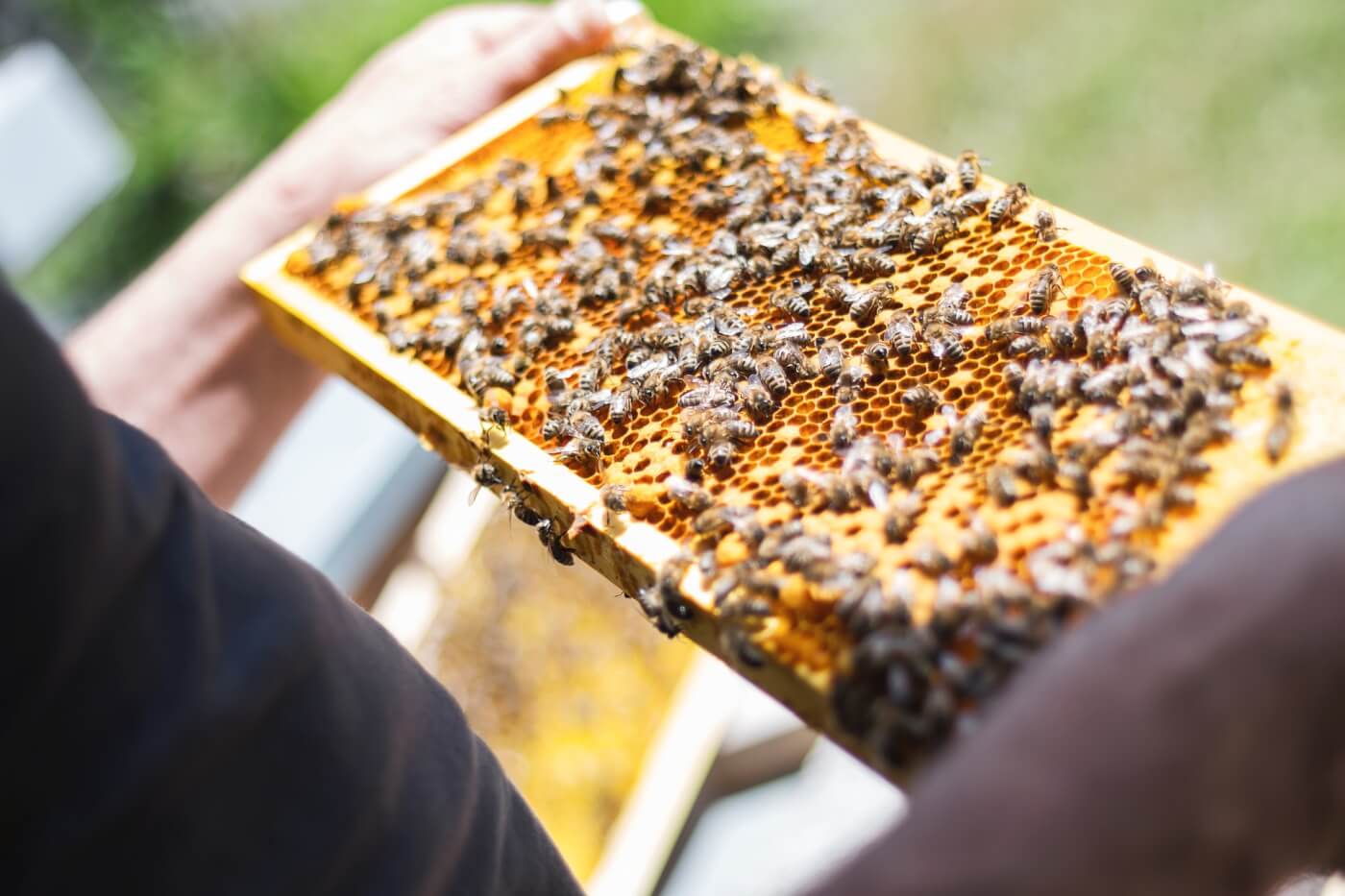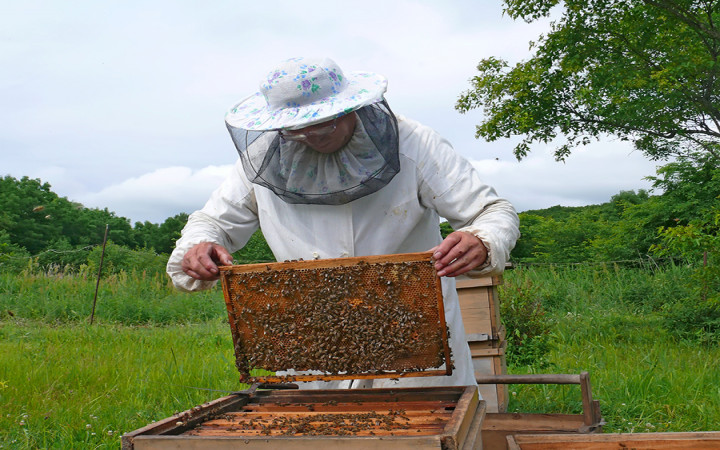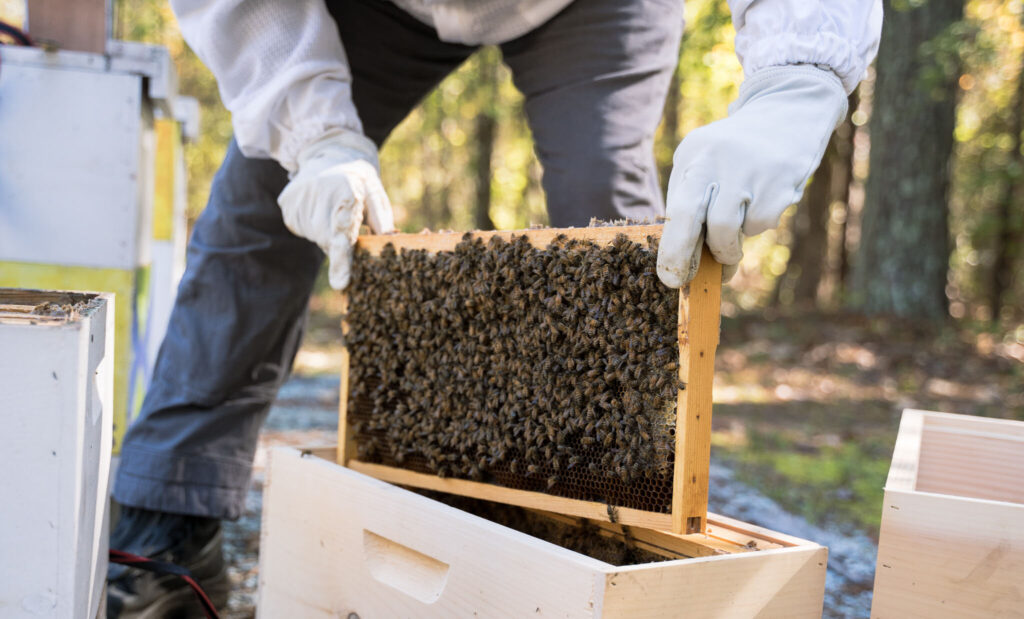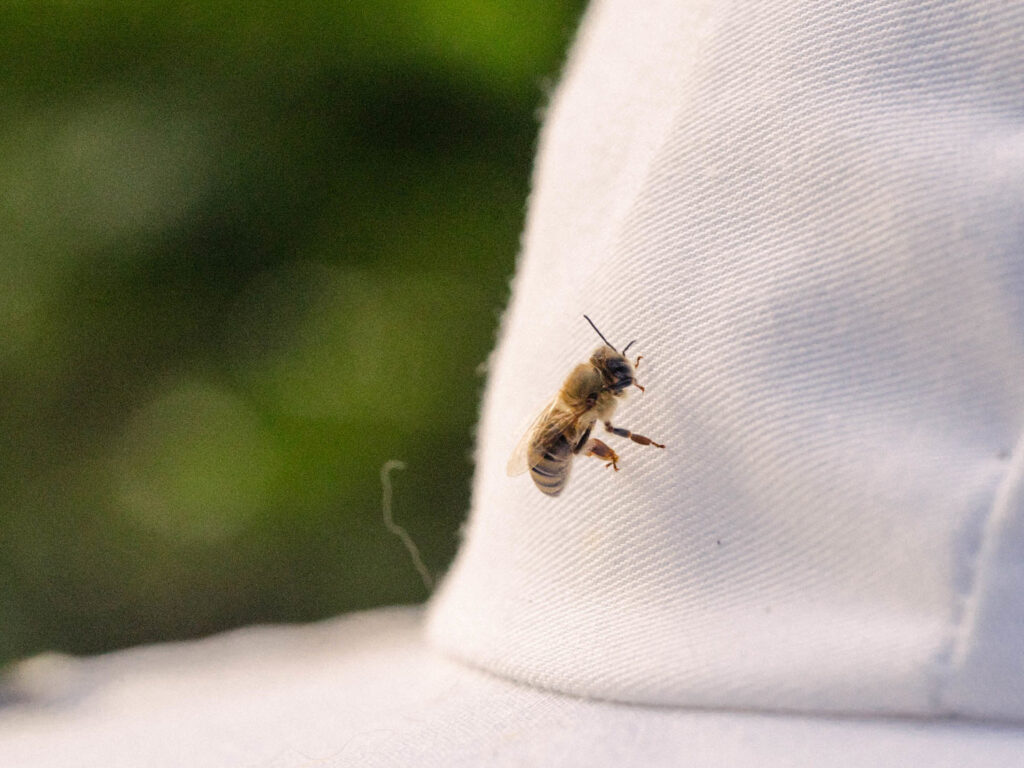
Have you ever wondered how beekeepers manage to work so closely with bees without getting stung? In this article, we’ll explore the fascinating techniques and protective gear that beekeepers use to keep themselves safe while tending to their buzzing friends. From the soothing power of smoke to the clever design of beekeeping suits, you’ll discover the secrets behind how beekeepers navigate the world of bees with minimal stings. So, if you’re ready to uncover the buzzing truth, read on!
1. Knowledge and Understanding of Bees
As a beekeeper, it is essential to have a deep knowledge and understanding of bees. This includes being able to identify their behavior and signals, studying their anatomy, and understanding their life cycle.
1.1 Identify Behavior and Signals
To minimize the risk of getting stung, it is crucial to be able to identify the behavior and signals that bees display. Bees communicate with each other using various movements and sounds, such as buzzing or dancing. By observing and interpreting these behaviors, you can better understand the bees’ mood and intentions.
For example, aggressive or defensive behavior may be indicated by increased buzzing, flying in tight circles, or head-butting. On the other hand, calm and content bees tend to move slowly and peacefully around the hive. By being aware of these signals, you can adjust your approach accordingly and avoid unnecessary agitation.
1.2 Study Bee Anatomy
Having a good understanding of bee anatomy is another important aspect of beekeeping. By knowing the different body parts, you can handle bees more confidently and minimize the risk of accidental stings.
Take the time to study the various body parts of a bee, such as the head, thorax, abdomen, wings, and stinger. By familiarizing yourself with the physical structure of bees, you can handle them more effectively and with greater precision.
1.3 Understand the Life Cycle
Understanding the life cycle of bees is essential for effective beekeeping and minimizing the risk of getting stung. Bees go through distinct stages of development, from egg to larva to pupa and finally to an adult bee.
By understanding these stages, you can anticipate the behavior and needs of the bees at different times. This knowledge allows you to approach the hive in a manner that is least disruptive to the bees, reducing the likelihood of aggressive or defensive responses.
2. Protective Clothing and Equipment
One of the key ways that beekeepers protect themselves from stings is by wearing appropriate protective clothing and equipment. This includes a full bee suit, veil and hat, gloves, boots, a smoker, and a bee brush.
2.1 Full Bee Suit
A full bee suit provides comprehensive protection by covering your entire body. It typically consists of a long-sleeved jacket, trousers, and removable gloves. The suit is usually made of a lightweight, breathable material that offers protection against bee stings, while still allowing you to move comfortably.
When choosing a bee suit, ensure that it fits well and has a hooded veil to protect your face and neck. The suit should be zipped all the way up to prevent any gaps where bees may find their way in.
2.2 Veil and Hat
A veil and hat are essential components of beekeeping protective gear. The veil is typically attached to the hat and acts as a barrier for your face and neck, preventing bees from coming into direct contact with your skin.
It is important to choose a veil that is made of a fine mesh material, allowing for good visibility while keeping bees at a safe distance. The hat should fit securely and comfortably, and some models even have a brim to provide additional protection from the sun.
2.3 Gloves
Wearing gloves is an effective way to protect your hands from bee stings. Beekeeping gloves are usually made of thick, leather material that provides both dexterity and protection. Opt for gloves with elastic cuffs to ensure a snug fit and prevent bees from getting inside.
However, it is worth noting that some experienced beekeepers prefer to forego gloves as they believe it allows for better control and sensitivity when handling the bees. Ultimately, the choice of wearing gloves depends on your personal comfort level and experience.
2.4 Boots
Beekeeping boots are designed to protect your feet and lower legs from potential bee stings. They are typically made of durable, waterproof materials and have a high ankle height. Look for boots with slip-resistant soles to ensure stability in the bee yard.
Choose boots that are comfortable and provide ample protection while still allowing for ease of movement. Remember to tuck your pants into your boots to prevent bees from crawling up your legs.
2.5 Smoker
A smoker is a crucial tool for beekeepers as it helps to calm the bees and reduce the risk of stings during hive inspections. The smoker generates cool smoke that is directed into the hive, interfering with the bees’ communication system.
By introducing smoke into the hive, the bees become less agitated and are more likely to remain calm and less defensive. However, it is important to use the smoker correctly to avoid damaging the bees or disrupting the hive.
2.6 Bee Brush
A bee brush is a gentle and effective tool for moving bees during inspections or harvesting honey. It allows you to nudge bees away from desired areas without causing harm or distress. Bee brushes are typically made of soft, natural bristles that are gentle on the bees while still providing effective guidance.
Using a bee brush can help to minimize the risk of accidentally squishing bees or causing them to become agitated, thus reducing the likelihood of stings.
3. Calm and Gentle Approach
When it comes to handling bees, maintaining a calm and gentle approach is critical to minimizing the risk of getting stung. Bees are highly sensitive to vibrations, sudden movements, and loud noises, so it is important to take a considerate and respectful approach.
3.1 Slow and Steady Movements
When approaching a hive or working with bees, it is important to move slowly and steadily. Sudden and jerky movements can startle the bees and trigger defensive responses. Instead, approach the hive with deliberate and purposeful movements, allowing the bees to acclimate to your presence.
By moving in a slow and steady manner, you signal to the bees that you are not a threat, reducing the likelihood of aggressive behavior. Take your time and work methodically to ensure a calm and stress-free environment for both you and the bees.
3.2 Minimize Vibrations
Beekeepers should aim to minimize vibrations around the hive, as these can agitate the bees and increase the risk of stings. Avoid stomping or banging nearby, as this can create disruptive vibrations that may alarm the bees.
When working with the hive or handling frames, try to make deliberate and gentle movements to minimize vibrations. This will help to maintain a peaceful environment for the bees and reduce the likelihood of defensive behavior.
3.3 Avoid Sudden Noises
Loud or sudden noises can startle bees and trigger defensive responses. When working around the hive, try to maintain a quiet and calm environment. Avoid shouting, slamming equipment, or playing loud music close to the hive.
By minimizing sudden noises, you create a more peaceful atmosphere for the bees. This reduces their stress levels and lowers the risk of stings.
3.4 Respect Bee Space
Bees have a concept of personal space, known as “bee space,” which refers to the optimal distance between comb structures. As a beekeeper, it is important to respect this space and avoid overcrowding or disturbing the bees unnecessarily.
When working with the hive, maintain a reasonable distance to avoid imposing on the bees’ territory. Intruding too closely can trigger defensive behavior, as the bees seek to protect their home. By respecting their space, you create a harmonious environment that minimizes the chances of being stung.
4. Proper Hive Maintenance and Inspection
Regular hive maintenance and inspections are essential for the health and well-being of the bees. By practicing proper hive maintenance, you can identify and address any potential issues before they escalate.
4.1 Regular Hive Checks
Performing regular checks on your hive allows you to monitor the overall health and condition of the bees. Look for signs of disease, pests, or parasites that may pose a risk to the colony.
During inspections, work slowly and methodically, avoiding sudden movements or rough handling of frames. By calmly and gently maneuvering through the hive, you reduce the chances of agitating the bees and triggering defensive behavior.
4.2 Maintain Healthy Hives
Maintaining healthy hives is crucial for minimizing stress and the likelihood of aggressive behavior in bees. Provide the bees with a clean and well-ventilated hive, ensuring that it is free from excess moisture or pests.
Regularly clean and inspect the hive equipment to prevent the buildup of debris or mold. Replace any damaged or deteriorated components promptly to maintain a safe and secure environment for the bees.
4.3 Identify Potential Issues
Part of being a proficient beekeeper involves identifying potential issues within the hive. Keep an eye out for signs of disease, such as unusual discoloration or deformed bees, as well as the presence of mites or other pests.
If you notice any abnormalities or concerns, consult with experienced beekeepers or local beekeeping associations for guidance. Addressing potential issues promptly can help maintain the health and productivity of the colony while minimizing the risk of stings.
4.4 Address Swarm Preparation
Swarming is a natural part of a bee colony’s reproduction process, but it can increase the potential for defensive behavior in bees. To minimize the risk of swarming and subsequent stinging, take proactive measures to manage swarming tendencies.
Regularly inspect the hive for signs of swarming preparation, such as the presence of queen cells or overcrowding. If indications of swarming are detected, take appropriate steps to prevent it, such as dividing the colony or providing additional space within the hive.
By addressing swarm preparation, you can maintain a more stable and balanced colony, reducing the potential for defensive behavior and stings.

5. Time of Day Matters
The time of day when you perform beekeeping tasks can greatly impact the bees’ behavior and the risk of getting stung. Being mindful of the timing and opting for optimal conditions can increase your chances of a successful, sting-free experience.
5.1 Choose Optimal Conditions
Selecting the right weather conditions is crucial when working with bees. Bees are generally more active and alert during warm and sunny weather, so choose days that offer favorable conditions.
Avoid working with bees during adverse weather conditions, such as strong winds, rain, or extreme temperatures. Unfavorable weather can agitate the bees, making them more reactive and increasing the chances of stings.
5.2 Avoid Disturbing Bees during Peak Activity
Bees are most active during mid-morning to mid-afternoon when foraging is at its peak. During these hours, bees are busy collecting nectar and pollen, making them less likely to respond defensively to human presence.
Avoid undertaking extensive hive inspections or other disruptive tasks during this period. By respecting the bees’ peak activity time, you minimize the chances of agitating them and being stung.
6. Use of Smoke
The use of smoke is a widely practiced technique in beekeeping to calm bees and reduce the likelihood of stings. Understanding the effect of smoke and using it properly is crucial to maintaining a peaceful hive environment.
6.1 Understanding Smoke’s Effect
When applied correctly, smoke interferes with the communication system of bees, making them less likely to respond defensively. The smoke triggers a response in bees that mimics a natural instinct to prepare for a potential forest fire. In response to the perception of fire, the bees focus on consuming honey in preparation for potential relocation.
By introducing cool smoke into the hive, you disrupt this response and promote a calmer environment for your inspection or other beekeeping tasks.
6.2 Applying Smoke Properly
To effectively use smoke, create a small fire with materials such as dried leaves, pine needles, or twigs. Allow the fire to produce cool smoke, avoiding any direct exposure to flames.
Apply the smoke gently to the entrance of the hive and around the frames. The smoke should be directed between the frames and into the corners of the hive to reach the bees more effectively.
Remember, the goal is to calm the bees and not to suffocate them. Moderation is key, so use smoke sparingly and observe the bees’ response. Properly applied smoke can help create a cooperative atmosphere and minimize the risk of stings.

7. Beekeeper’s Experience and Expertise
Experience and expertise play a vital role in a beekeeper’s ability to avoid getting stung. With time and practice, beekeepers develop skills and learn valuable techniques to reduce the likelihood of being stung.
7.1 Develop Skills through Practice
Handling bees confidently and efficiently comes with practice. Gradually build your experience by working with bees regularly and implementing safe handling techniques. With each interaction, you will become more comfortable and adept at managing the bees.
Focus on honing your skills, such as frame handling, recognizing bee behavior, and swift yet gentle movements. The more you practice, the better equipped you will be to navigate the hive environment without agitating the bees.
7.2 Learn from Experienced Beekeepers
Learning from experienced beekeepers is an invaluable resource in minimizing the risk of stings. Seek out mentorship or join local beekeeping associations to connect with knowledgeable beekeepers who can share their experiences and insights.
By learning from those who have already developed effective techniques and strategies, you can adopt proven methods and avoid potential pitfalls. Experienced beekeepers can provide guidance tailored to your specific circumstances, helping you refine your skills and minimize the risk of stings.
7.3 Attend Workshops and Conferences
Attending workshops and conferences focused on beekeeping offers opportunities to enhance your knowledge and learn from industry experts. These organized events provide a platform to exchange ideas, share experiences, and acquire new techniques for beekeeping.
By participating in these educational activities, you can stay updated on the latest advancements in beekeeping practices and gain valuable insights into sting prevention. Networking with fellow beekeepers can also provide a supportive community where you can discuss concerns and seek advice.
8. Genetic Traits of Bees
Bees have different genetic traits that can influence their behavior and disposition. As a beekeeper, understanding these traits is important for managing colonies that are less prone to aggression and stinging.
8.1 Selecting Gentle Bee Strains
When acquiring bees for your apiary, consider choosing strains that are known for their gentle behavior. Some bee strains, such as the Italian or Carniolan bees, have been bred for their calm and docile nature.
By selecting gentle bee strains, you increase the likelihood of working with bees that are less prone to stinging. These strains are typically more tolerant of human presence and less likely to respond defensively.
8.2 Breeding Calm and Passive Bees
Beekeepers also have the option to selectively breed bees that exhibit calm and passive characteristics. Through a process known as selective breeding, beekeepers can encourage desired traits in their colonies.
By breeding bees that are less prone to stinging, you can gradually develop a population of bees that are more manageable and less prone to defensive behavior. However, selective breeding requires careful planning, evaluation, and patience to ensure successful results.
9. Allergies and Personal Precautions
Beekeepers should also be aware of any personal allergies and take necessary precautions to minimize the risk of severe reactions to bee stings.
9.1 Regular Medical Check-ups
Regular medical check-ups are essential for maintaining good health, including monitoring for potential allergies. If you suspect that you may be allergic to bee stings or have a history of severe allergic reactions, consult with a healthcare professional.
Discuss your beekeeping activities and consider undergoing specific tests, such as allergy testing or venom immunotherapy, to better understand any potential risks or precautions needed. By staying informed about your health, you can take necessary steps to prevent adverse reactions.
9.2 Awareness of Personal Allergies
It is important to be aware of your own allergies and take precautions accordingly. While most beekeepers may experience minor local reactions to stings, individuals with allergies face a higher risk of severe allergic reactions.
If you have known allergies to bee stings, wear a medical identification bracelet or necklace that specifies your allergy. This can be extremely helpful in the event of an emergency, ensuring that others are aware of your condition and can provide appropriate assistance.
9.3 Use of Epinephrine Auto-Injectors
For individuals with severe allergic reactions to bee stings, carrying an epinephrine auto-injector is highly recommended. Discuss with your healthcare provider about obtaining a prescribed auto-injector and learn how to use it correctly.
Having an auto-injector readily available while working with bees provides an added layer of safety in case of a severe reaction. Be sure to replace your auto-injector before it expires to ensure its effectiveness when needed.
10. Environmental Factors
Environmental factors, such as fragrances or scented products, can also impact the behavior of bees. Being mindful of these factors and minimizing their presence can contribute to a more harmonious beekeeping experience.
10.1 Avoid Strong Fragrances
Bees are attracted to strong fragrances, such as perfumes, scented lotions, or floral-scented personal care products. Avoid wearing such items when working with bees as they can make the bees more curious or agitated.
Opt for unscented personal care products and avoid using heavily scented cleaning supplies near the hive. By minimizing strong fragrances, you reduce the likelihood of attracting unnecessary attention from the bees.
10.2 Minimize Use of Perfumes or Scented Products
When visiting the hive or any beekeeping activity, it is best to avoid wearing perfumes or scented products altogether. Bees have a highly sensitive sense of smell and can be attracted to the scents, increasing the chances of stings.
By refraining from using perfumes and scented products, you create a more neutral environment that is less likely to disrupt the bees and provoke aggressive behavior.
In conclusion, beekeepers employ a combination of knowledge, protective clothing, gentle approach, proper hive maintenance, timing, and experience to minimize the risk of getting stung. By understanding bee behavior, being equipped with appropriate gear, and adopting a calm and respectful approach, beekeepers can work harmoniously with bees while minimizing the likelihood of stings. Regular hive maintenance, selective breeding, and attending educational events contribute to an ongoing learning process that optimizes beekeeping practices. Awareness of personal allergies and environmental factors further ensures the safety and well-being of both the beekeeper and the bees. With these strategies in place, beekeepers can enjoy the rewarding experience of beekeeping while minimizing the risk of stings.
